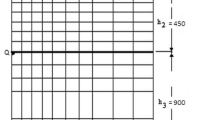Abstract
Bituminous blocks are utilized for road construction all over the world in the name of historical pavement. Bituminous block pavement has a number of advantages in terms of faster construction and maintenance of road projects. The performance of any pavement structure is generally influenced by the thickness of the layer provided, which is determined by the structural and physical properties of the materials available for construction. Only a few experimental experiments on bituminous block pavement have been conducted. No studies were reported on the effective thickness of bituminous block pavement using the finite element technique. The multiple constraints associated with conducting experimental work on bituminous blocks of different thicknesses can be reduced by employing a finite element technique. Bituminous block pavement was tested in this study by altering the thickness, which was fixed according to the code specification. The bituminous block pavement thicknesses employed in this investigation were 50 mm, 55 mm, 60 mm, and 65 mm. ABAQUS software was used to perform a finite element study of the bituminous block pavement. The analysis showed that as pavement thickness increases, the deformation values decrease. The minimum and maximum deformation obtained is about 8–24% and 7–17%, respectively. The effective thickness of the bituminous block pavement was fixed based on the strain values obtained from the finite element approach.
Access this chapter
Tax calculation will be finalised at checkout
Purchases are for personal use only
Similar content being viewed by others
References
Vignesh D, Padmakumar R (2021) “Effect of joint width and sealing material on performance of bituminous block pavement using finite element method.” IJERT 9(6):37–41
Zhang H, Wu J, Fu X, Sui B, Lv L (2018) Comparative study on mechanical characteristics of precast HMA block versus concrete block. Int J Pavement Eng 0(0):1–10. https://doi.org/10.1080/10298436.2018.1497799
Abdelgalil A, Nor H (2014) The influence of block thickness on the performance of asphalt paving blocks. Res J Appl Sci Eng Technol 7(10):2129–2134. https://doi.org/10.19026/rjaset.7.507
Ahirwar SK, Mandal JN (2017) Finite element analysis of flexible pavement with geogrids. Procedia Eng 189(May):411–416. https://doi.org/10.1016/j.proeng.2017.05.065
Ali G, Family A, Pourzand B, Abad H (2014) Numerical analysis of concrete block pavements and comparison of its settlement with asphalt concrete pavements using finite element method. 18(4):39–51. https://doi.org/10.4186/ej.2014.18.4.39
Hamim A, Izzi N, Ceylan H, Atmaja S, Rosyidi P, El-shafie A (2018) Comparative study on using static and dynamic finite element models to develop FWD measurement on flexible pavement structures. Constr Build Mater 176:583–592. https://doi.org/10.1016/j.conbuildmat.2018.05.082
Masad E, Somadevan N (2002) Microstructural finite-element analysis of influence of localized strain distribution on asphalt mix properties. J Eng Mech 128(10):1105–1114. https://doi.org/10.1061/(ASCE)0733-9399(2002)128:10(1106)
Elseifi MA, Baek J, Dhakal N (2018) Review of modelling crack initiation and propagation in flexible pavements using the finite element method. Int J Pavement Eng 8436:1–13. https://doi.org/10.1080/10298436.2017.1345555
Hashim S, Satyakumar M (2018) “Finite element analysis of coir fiber reinforced bituminous pavements.” V(XI):1–5
Hu C (2009) “Three dimensional finite element analysis of top-down cracking for asphalt pavements.” ASCE 2009(Icte):3248–3253
Wang X, Wang J, Qiu Y (2019) “Finite element analysis of thiopave modified asphalt pavement.” 48–57. doi:https://doi.org/10.4236/wjet.2019.72B006
Kumbargeri Y, Boz I, Kutay ME, Heidelberg A (2019) A study on the effects of aggregate shape and percent embedment on chip seal performance via image-based finite element analysis. Int J Pavement Eng 0(0):1–10. https://doi.org/10.1080/10298436.2019.1654104
Nejad FM, Shadravan MR (2006) “A study on behavior of block pavement using 3D finite element method.” 1984:349–358
Taylor P, Myers LA, Roque R, Birgisson B (2014) “Use of two-dimensional finite element analysis to represent bending response of asphalt pavement structures use of two-dimensional finite element analysis to represent bending response of asphalt pavement structures.” 37–41. doi:https://doi.org/10.1080/10298430108901727
IRC 37 (2018) Guidelines for the design of flexible pavements, 4th Revision
Morth (2013) Specifications for road and bridge. 3rd Revision
Acknowledgements
The authors gratefully acknowledge the APJ Abdul Kalam Technological University, Kerala for the technical support and the All-India Council for Technical Education (AICTE) for funding this project under Research Promotion Scheme-National Doctoral Fellowship (RPS-NDF).
Author information
Authors and Affiliations
Corresponding author
Editor information
Editors and Affiliations
Rights and permissions
Copyright information
© 2024 The Author(s), under exclusive license to Springer Nature Singapore Pte Ltd.
About this paper
Cite this paper
Dhurai, V., Radhakrishnan, P., Joseph, D. (2024). Evaluation of Effective Thickness of Bituminous Block Pavement Using Finite Element Approach. In: Singh, D., Maji, A., Karmarkar, O., Gupta, M., Velaga, N.R., Debbarma, S. (eds) Transportation Research. TPMDC 2022. Lecture Notes in Civil Engineering, vol 434. Springer, Singapore. https://doi.org/10.1007/978-981-99-6090-3_19
Download citation
DOI: https://doi.org/10.1007/978-981-99-6090-3_19
Published:
Publisher Name: Springer, Singapore
Print ISBN: 978-981-99-6089-7
Online ISBN: 978-981-99-6090-3
eBook Packages: EngineeringEngineering (R0)




